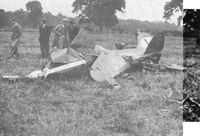Фотографии
-
Регистрационный номер: G-AETK [3] The T.K.4 in its final form, ready for the 1937 King's Cup Air Race. Note the small diagonal strut added to the Perspex hood, probably for quick release, and the hole just forward of the wings below the engine cowling.
Самолёты на фотографии: De Havilland Technical School T.K.4 - Великобритания - 1937
-
Регистрационный номер: G-AETK [3] A good impression of the T.K.4, piloted by Bob Waight, getting its tail skid off Hatfield Aerodrome at the start of the King's Cup Eliminating Race on Friday.
The T.K.4 takes off from Hatfield at the start of the 1937 King’s Cup Race on September 11. R. J. Waight averaged 230-5 m.p.h. for the course, but was placed ninth. The aircraft is seen in its attractive paint scheme of overall high gloss red with white letters and trim.Самолёты на фотографии: De Havilland Technical School T.K.4 - Великобритания - 1937
-
The T.K.4 immediately after completion, at Hatfield in 1937. It first flew on October 30 with the Class B markings E-4.
Самолёты на фотографии: De Havilland Technical School T.K.4 - Великобритания - 1937
-
Регистрационный номер: G-AETK [3] The T.K.4 G-AETK photographed on October 1, 1937 just after the crash in which de Havilland chief test pilot Bob Waight was killed. Built by de Havilland Technical Aeronautical School students, this remarkable aeroplane was virtually a faired-in 140 h.p. D.H. Gipsy Major II engine with 19ft 8in wingspan, retractable undercarriage, variable-pitch propeller and slots and flaps. After averaging 230-5 m.p.h. in the 1937 King's Cup air race, Waight was practising near Hatfield for an attempt on the 100km class record when the T.K.4 crashed.
Самолёты на фотографии: De Havilland Technical School T.K.4 - Великобритания - 1937
-
de Havilland Technical School T.K.4
Самолёты на фотографии: De Havilland Technical School T.K.4 - Великобритания - 1937
Статьи
- -
- Avro 504K (Dyak) /Preservation Profile/ (57)
- News Spotlight
- Personal album
- A.Carlisle - Christmas mission
- A.Ord-Hume - T.K.4 /British pre-war ultralights/
- B.Martin - Britain's civil aircraft register
- E.Morgan, C.Burnet - Seafang
- E.Rees - Cierva's triple rotor chopper
- L.Benjamin - Fall Guy
- N.Williams - Handling the Heinkel
- P.Anderson - Moth Monoplane
- R.Lindsay - Gloster Javelin /Fighters of the fifties/ (17)




